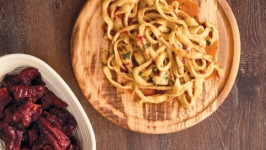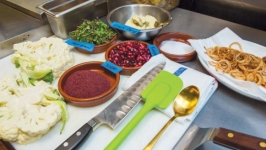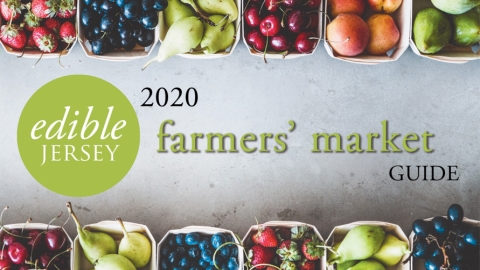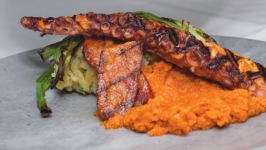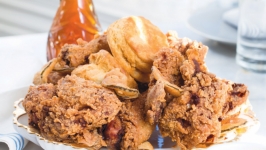Meet Chef Joseph Voller of Il Nido, Marlboro
“I’VE NEVER SEEN A PASTA WITH ONLY FOUR THINGS IN IT MAGNIFY ITS WAY OUTWARD. THE SUM IS SO MUCH GREATER THAN THE PARTS.”
—Joseph Voller, chef
The menu at Il Nido in Marlboro offers an enticing mix of grilled seafood, pastured meats and inspired antipasti. Yet, Executive Chef Joseph Voller is confident that if he offered to cook any menu item for his staff, the overwhelming choice would be a humble mix of handmade pasta tossed with toasted garlic, Pecorino and dried Italian peppers. “Ask anyone on my staff what they want to eat, [and] nine out of ten, or ten out of ten, are going to say mugnaia,” Voller says, “It is one of the most special pastas I’ve ever had. It’s incredibly simple in its ingredient list, and incredibly difficult to execute.”
Voller is quick to acknowledge that his preparation of this traditional dish from the Abruzzo region of Italy is not his own recipe, but rather one that he learned from Antonietta Marrone, co-owner of Ristorante La Bilancia in Loreto Aprutino. In a lesson arranged by the owners of Le Virtù in Philadelphia, where he was the executive chef at that time, Voller spent an entire day in La Bilancia’s kitchen learning to make the single- strand, hand-pulled noodle that is the foundation of this dish.
Described by Voller as an Abruzzese version of the Chinese longevity noodle, the pasta is made from a combination of soft and hard wheats, including heirloom varieties of Sicilian wheat, that together produce the desired soft, chewy texture. After kneading together flour and water, Voller pokes a hole in the center of a 250-gram flattened ball of dough to create a donut shape, which he begins to work into a ring of pasta that becomes increasingly longer and thinner. A combination of rolling, squeezing and gravity results in a 12- to 14-foot-long continuous loop of pasta that is about the thickness of fettuccine.
During his pasta-making lesson at La Bilancia, Voller made noodle after noodle as Marrone corrected him by grabbing his hands to demonstrate the proper amount of pressure to exert. Squeezing too hard changes the shape of the noodle, while squeezing too softly creates a thick noodle that becomes dense and chewy when cooked. “I came close, but I still didn’t get it right,” Voller says. “It took me coming home and making them every day for a couple of months until I finally got this thing down. It’s so simple and yet so technical, which is why I love it.”
Voller uses a single, continuous 250- gram noodle for each serving of mugnaia. The pasta is cooked in water that he salts to the level of well-seasoned soup.
As the pasta cooks, olive oil and thinly sliced garlic are added to a wide, unheated pan, which is then heated until the garlic just starts to show color. Voller deviates from Marrone’s recipe by also adding shallots in with the garlic. Next, he adds Calabrian peppers (another deviation that adds extra heat to the dish) and cruschi peppers, a sundried-then-fried chili pepper that Voller imports from Abruzzo. While noting that the aromatic, fruity cruschi pepper is what makes this dish special, Voller says that a local substitution can be made by dehydrating Jimmy Nardello peppers, which are grown in New Jersey by a few specialty growers including Z-Food Farm in Lawrenceville and Ironbound Farm in Asbury.
Pasta water is then added to the pan and allowed to simmer—bringing out the flavor of the peppers as it cooks down. When the pasta is about 90% cooked, it is added to the pan, tossed well with the garlic and peppers and cooked until done, about another minute and a half.
At Il Nido, Voller finishes the dish with parsley and a hit of lemon juice, as well as grated Pecorino Romano. Because it adds a critical layer of flavor and seasoning, he recommends buying the best Pecorino that you can afford. (Voller uses an organic Pecorino Romano imported by Pondini and available at the Whole Earth Center in Princeton, Madison Market in Madison and MOM’s in Cherry Hill.)
Learning to make mugnaia changed Voller’s approach to cooking. A dish that relies on the careful handling of just a few high-quality ingredients inspired him to avoid overcomplicating his own cooking. Instead, he seeks out the finest ingredients from small purveyors and prepares them in simple ways that let the ingredients shine.
“I’ve never seen a pasta with only four things in it magnify its way outward. The sum is so much greater than the parts,” Voller says. “When all of it comes together— the chew, the texture, the heat, the fruitiness from the pepper—everything is so well balanced. You just walk away and are like, ‘That was a perfect plate of food.’”
IL NIDO • 184 Route 9 North, Marlboro • 732.851.6347 • ilnidonj.com
- EDITOR’S NOTE: Il Nido offers outdoor dining; please confirm in advance.



